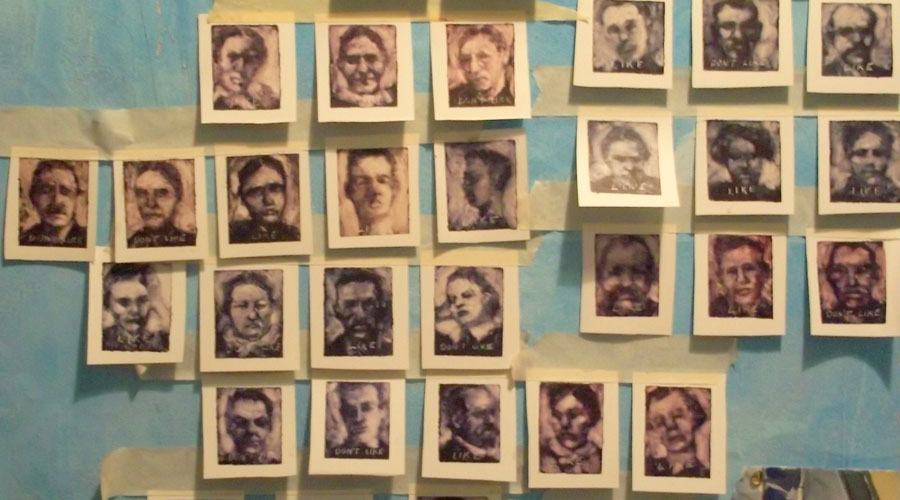Getting a glimpse at someone’s innermost hidden self is a consistent goal in the field of psychology, and one of the biggest advances came in 1935 with the Szondi Test. Designed by the Hungarian psychiatrist Leopold Szondi, the goal was to explore the deepest repressed impulses of a person on the basis of sympathy or aversion. The method for going about this exploration — determining which photo in a lineup of psychopaths caused the test subject the most discomfort. The general notion is that certain characteristics that bother us in others are those that we developed an aversion to at an early age and are now repressed.
Taking the test is pretty simple, just look at the eight photos in the lineup and pick the person you would least likely want to encounter in a dark alley alone. Each photograph has an interpretation that corresponds with the repressed impulses. Then read the interpretation that corresponds to the number of the portrait that stands out to you. Each photo is meant to represent a stimulus that can detect repressed and denied impulses in a person.

It’s definitely important to note, that the test doesn’t imply any sort of mental disorder, it was merely designed to make an assumption about potential repressed impulses according to the psychoanalysis theory. In short, in no way does it imply you’re a psycho. While the original test included 42 different portraits, this is a condensed version.
The interpretations
1. Sadist Repression: Individuals who selected the first picture may have repressed experiences from the earlier years of life, especially those associated with authoritarianism over their behavior.
Denial: Individuals that fall into this category may show a psychology that chooses passive resistance and defiance, which can exhaust those who have authority over you, such as a superior at work.
2. Epileptic Repression: Personality disorders associated with brain disease and dysfunction (as occurs in some cases of epilepsy), can have diagnostic traits such as irritability, impulsiveness, and outbursts of aggression. It’s possible that those who selected this individual may have some repressed feelings and behaviors associated with anger from early childhood.
Denial: Being that individuals who fit this category have repressed feelings of impulsiveness and anger, they likely give an impression of being friendly, peaceful and have the ability to bond well with ideas and others.
3. Katatonic Repression: For those who felt uneasy about the man in this photo, it’s possible they may have repressed hyperactivity, that can cause them to at times lose touch with reality. Features of this mental disorder are the excessive stimulation of imagination and cognition in general.
Denial: Individuals may find it particularly difficult to adapt new situations and have a fear of losing control. This can often play out in being overly defensive and inhibit a person from being vulnerable at times out of fear of deviating from their rigid normal behavior.
4. Schizophrenic Repression: The schizophrenic personality is characterized by intense apathy and severe distortions of thought and emotion. Individuals may have repressed feelings of indifference towards others and have withdrawn from being social early on in life.
Denial: A general openness to being social and communicating with others, especially the enjoyment of going out with company. The social aspect can be misleading and the individuals relationships may feel superficial with an inner feeling that coexisting with others is not needed at all.
5. Hysteric Repression: Personality traits of those who may be classified as hysterical often exhibit unstable emotions, narcissism, and superficial exhibitionism. This is often done in need to captivate attention and severe desire for approval.
Denial: This individuals may give off the impression of a modest person, but in reality that shyness is likely masking an overpowering and excessive desire to charm others and gain their attention.
6. Depressive Repression: The overall personality disorder that stands out in people who fall into this category is a lack of self-esteem, accompanied by feelings of inferiority or guilt.
Denial: Individuals may try to mask a feeling of melancholy and apathy with an outgoing and carefree approach to life. Confidence and optimism can be shown, but are often unbalanced compared to feelings of sadness and negativity.
7. Maniac Repression: Diagnostic features of mania may come out in various forms of extroversion, overstimulation, recklessness with money and emotions. Those who were bothered by the face in photo number 7 may have trouble controlling themselves at times and have a tendency to be overconfident.
Denial: People who fit into the maniac category may try to deny their mania by not provoking wild behavior and have an aversion to noise and excess. They will strive to often exercise control, measure and logical behavior.
8. Dissociative identity disorder Repression: This type of personality manifests in a person’s desire to live as a member of the opposite sex. If the man in the photo seems troublesome and depraved, it’s possible that this is linked to a childhood repressed an identity or conflict about one’s gender.
Denial: People may have a desire to emphatically confirm their biological sex through their dress and mannerisms. In this case, individuals may work to overemphasize there gender in their behavior and dress so that others have no doubt about their gender.
Again, it’s important to note that this test doesn’t imply any sort of mental disorder and when it was designed 80 years ago, homosexuality was still considered a mental disorder. It’s simply making an assumption, a guess, about the desires and impulses that are in all of us.

